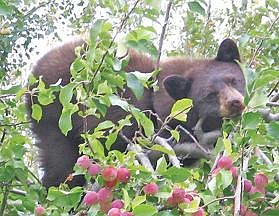Wildlife officials offer tips on bears
With the arrival of spring and an increase in outdoor recreation opportunities, ventures into the backcountry will on many occasions include episodes of interaction between humans and bears.
In an effort to educate the public about grizzly bears and the more common black bears, Montana Fish, Wildlife and Parks officials put together an array of information. Kim Annis, a wildlife biologist in Libby, said that the adaptable and curious American black bear occupies approximately 45 percent of western and west-central Montana.
Annis reported that wildlife biologist Rick Mace is heading up a study to learn more about black bear populations in relation to impacts from hunting.
“The study will estimate bear population size and harvest rate using DNA hair snares placed in eight bear management units and three hunting districts," said Tonya Chilton, FWP wildlife research technician assisting with the research. “The information gained from the study will help document Montana's black bear populations and evaluate black bear harvest strategies.”
An average of 1,000 black bears are harvested annually in Montana with more than 50 percent occuring in northwestern Montana’s Region 1, Annis said.
Annis reported that black bears prefer the security of heavy timber and canopied forests over open shrubfields – except when abundant berry production draws them out. She added that last year’s huckleberry and berry crops should translate into some healthy bear cubs this spring.
Most conflicts between black bears and humans are the result of attractants, such as food. Annis said that securing such attractants can be very effective at preventing a potential conflict.
“While many wild animals, including bears, can be dangerous under the right circumstances, especially if surprised or threatened, bears are normally shy and reclusive creatures," Annis said.
Annis said that recent research by FWP in the Cabinet Yaak Ecosystem found that many people who express a fear of bears are unaware of how many people are attacked or killed by grizzlies each year in the lower 48 states.
“Based on the analysis of existing statistics, about three people are killed in bear attacks annually, including polar bears, in North America,” Annis said. “In the CYE there have been no known cases of a grizzly injuring a human in the past 35 years.”
FWP statewide information officer Diane Tipton reported that after 26 years, the Yellowstone grizzly bear population had been declared recovered. The bears were removed from the federal list of endangered and threatened wildlife species in April 2007, though grizzlies in the Yellowstone Ecosystem still face challenges.
“Human-caused grizzly mortalities continue to be scrutinized, especially for female grizzly bears that are critical to the survival of the bears in the Yellowstone Ecosystem,” said Chris Smith, FWP deputy director and a longtime member of the Interagency Grizzly Bear Committee. “A serious issue for grizzly bears is the unprecedented attack of mountain pine beetles on whitebark pines.”
Whitebark pine seeds are a staple in grizzly bears' diets in the Greater Yellowstone and Northern Continental Divide Ecosystems, Tipton said. Some biologists fear that the loss of whitebark pine seeds could lead to less reproductive success among the grizzlies.
“Providing areas where grizzlies can expand their range and find new foods will be an important part of helping the bears cope with the loss of whitebark pine trees,” Smith said.
Although estimates put the grizzly bear population in 2004 at around 765 in the Northern Divide ecosystem – which includes portions of Wyoming, Montana, Idaho and Washington – the number in the Cabinet-Yaak Ecosystem is only around 40. That figure gives northwestern Montana the smallest grizzly population in the state, Tipton reported.
FWP has been working with the U.S. Fish and Wildlife Service to boost the grizzly population in the Cabinet-Yaak Ecosystem by transplanting a limited number of young female bears. The effort has seen success but also recent setbacks. Two female bears released into this ecosystem in 2008 died about two months after their release – one was struck by a train and the other shot and killed at a residence outside of Noxon.
Tipton said that the work to increase the grizzly population in northwestern Montana will continue.

